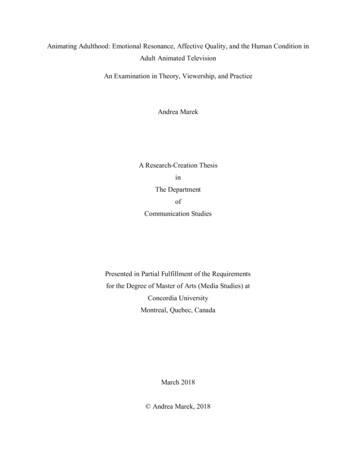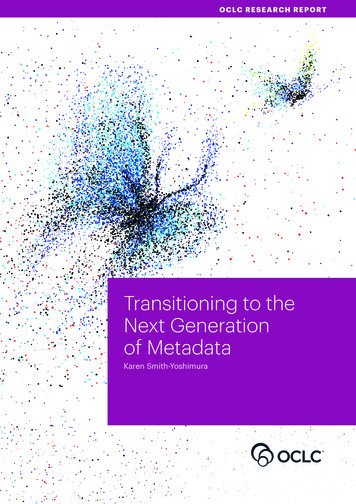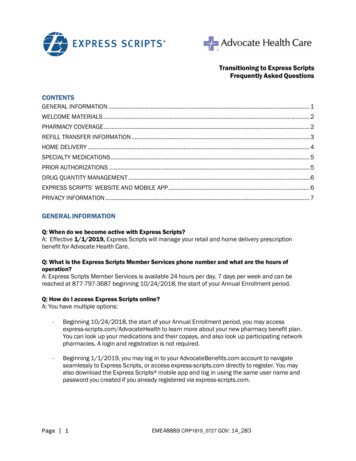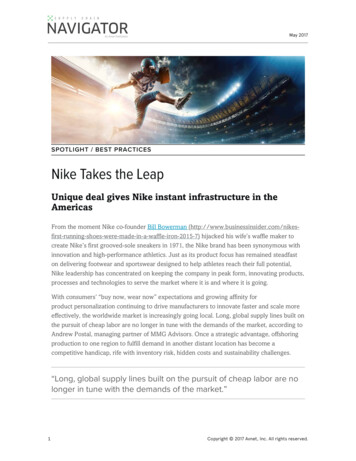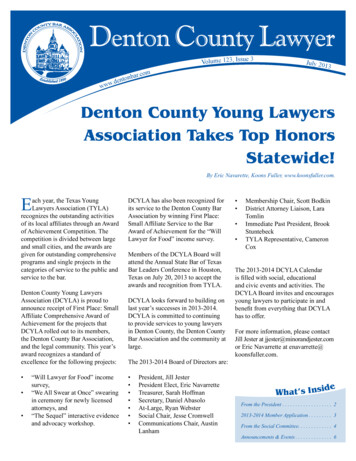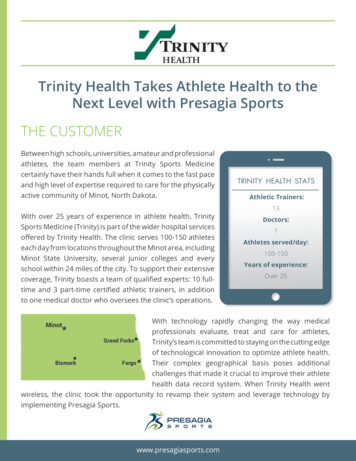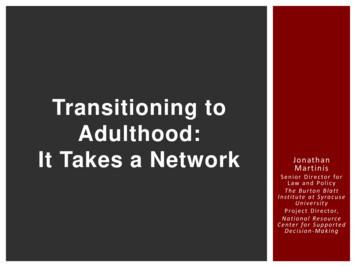
Transcription
Transitioning toAdulthood:It Takes a NetworkJonathanMartinisS e n i o r D i r e c to r fo rL a w a n d Po l i c yT h e B u r to n B l a ttI n s t i t u te a t S y r a c u s eUniversityP ro j e c t D i r e c to r,N a t i o n a l Re s o u r c eC e n te r f o r S u p p o r te dDecision-Making
T HE M ORE T HINGS C HANGE “The children now loveluxury. They have badmanners, contempt forauthority; they showdisrespect for elders andlove chatter in place ofexercise.”- Socrates2
T HE M ORE T HEY S TAY T HE S AME”I would there were no agebetween ten andthree-and-twenty, or thatyouth would sleep out therest; for there is nothing inthe between but gettingwenches with child, wrongingthe ancientry, stealing, fighting.”- William ShakespeareNational Resource Center for Supported Decision-MakingEVERYONE has the Right to Make Choices3
COME ON!Why can't they belike we were,perfect in every way?What's the matter withkids today?-Bye Bye BirdieNational Resource Center for Supported Decision-MakingEVERYONE has the Right to Make Choices4
C H -C H -C H -C HANGES“The toddler must say no in order to findout who she is. The adolescent says no toassert who she is not.”- Louise J. Kaplan“[G]rumble by eye roll, snide comment byquestionable fashion choice, our adolescentis learning to be independent.”- Martinis, 2015National Resource Center for Supported Decision-MakingEVERYONE has the Right to Make Choices5
I T A IN ’ T A LWAYS P RETTY0atNational Resource Center for Supported Decision-MakingEVERYONE has the Right to Make Choices6
B UT I T W ORKS“As she grows and matures, society willreward her with increased privileges andresponsibilities: driving, voting,opportunities for higher education, for acareer, property ownership, and a family.”- Martinis, 2015National Resource Center for Supported Decision-MakingEVERYONE has the Right to Make Choices7
A C RITICAL D IFFERENCE Students without disabilities: “students . . . andfamilies typically navigate with the assistance of aguidance department and the parent’s personalexperience” Students with disabilities: “Figuring out who thedifferent service provider representatives are andwhat their roles are can take on a life of its own thatoften overwhelms families, mostly because thedifferent service systems are not always clear onwhat their roles are or get into territorial roledefinitions that impact forward progress andplanning.”- Gustin, 2015National Resource Center for Supported Decision-MakingEVERYONE has the Right to Make Choices8
S URVEYA ND T HOSE M OST AT R ISK ?OF 13-17 Y EAR O LDS IN F OSTER C ARE 75% DO NOT have an Education and Career Path Plan (Florida lawrequires career planning before exiting Middle School) 34% have an IEP, 34% don’t know if they have one 34% have “no one” who attends parent/teacher conferences withthem, 36% have “no one” who helps them with school work @50% have NOT been told about educational waivers,scholarships and programs Only 9% are employed, 52% are NOT learning job skills, 61% say they need help/skills to find work but 62% have NOTbeen told about vocational programs 54% have NOT created a Independent Living Transition Plan (ordon’t know if they did).Florida Dept of Child and Family Services , 2015,http://www.dcf.state.fl.us/programs/indliving 5%20Final.pdfNational Resource Center for Supported Decision-MakingEVERYONE has the Right to Make Choices9
W HAT H APPENS ?18-22 Y EAR O LDS A GEDF OSTER C ARETHENS URVEYOFOUT OF 7% employed full-time, 21% part time 19% received vocational training 53% did NOT lead their independent living plan 72% had been homeless 24% had “couch surfed” due to no place to liveFlorida Department of Children and Families, /docs/2015%20Spring%20Florida%20NYTD.pdfNational Resource Center for Supported Decision-MakingEVERYONE has the Right to Make Choices10
N O M ATTER W HO YOU A RE : O NE G OAL“The steps out of school should allow for afoundation that will foster a lifetime ofopportunity and happiness. Many of the meansto achieving those outcomes are the same:enrollment in post-secondary education,vocational training programs, experiencingwork, and developing social networks thatfoster long-term meaningful relationships andopportunity for continued growth.”Gustin, 2015National Resource Center for Supported Decision-MakingEVERYONE has the Right to Make Choices11
T HE P ROBLEM :L ACK OF C OORDINATIONThe “fragmented system of services withinhigh schools and adult services . . .contributing to the failure . . . to prepareyouths [with special needs] for the future.”Katsiyannis, deFur, & Conderman, 199812
T HE S OLUTION :A C ULTURE OF C OORDINATED S UPPORTState and System-Wide agencies andorganizations providing appropriatesupports and services AND collaboratingwith others to coordinate, complement, andsupplement those services and supports.Gustin, Martinis, & Blanck (in press)National Resource Center for Supported Decision-MakingEVERYONE has the Right to Make Choices13
P UT A NOTHER WAYHow Did YOU transition? Develop short/long term goals Identify opportunities Complete college applications Write a resume Get a job“Most likely all of these experiences happenedwith support, either from your family ormentors.”Gustin, 2015National Resource Center for Supported Decision-MakingEVERYONE has the Right to Make Choices14
W HERE I S T HE S UPPORT F OR T HOSEM OST AT R ISK ? 75% DO NOT have an Education and Career Path Plan 65% do not have an IEP or don’t know 34% have “no one” who attends parent/teacher conferences withthem, 36% have “no one” who helps them with school work @50% have NOT been told about educational waivers,scholarships and programs Only 9% are employed, 52% are NOT learning job skills, 61% say they need help/skills to find work but 62% have NOTbeen told about vocational programs 54% have NOT created a Independent Living Transition Plan (ordon’t know if they did).Florida Dept of Child and Family Services , 2015,http://www.dcf.state.fl.us/programs/indliving 5%20Final.pdfNational Resource Center for Supported Decision-MakingEVERYONE has the Right to Make Choices15
S URVEYOFH ERE I T I S :13-17 Y EAR O LDS I N F OSTER C ARE 75% have an adult in their life they can go tofor support 70% have reviewed career interests with anadult (21% with GAL) 95% have learned about interpersonalrelationships 54% have learned about budgeting 66% have discussed medical care with anadultNational Resource Center for Supported Decision-MakingEVERYONE has the Right to Make Choices16
C OORDINATED S UPPORT G OAL :E MPOWERING S ELF -D ETERMINATION Life control People’s ability and opportunity to be“causal agents . . . actors in their livesinstead of being acted upon”Wehmeyer, Palmer, Agran, Mithaug, &Martin, 2000National Resource Center for Supported Decision-MakingEVERYONE has the Right to Make Choices17
B ENEFITS OF S ELF -D ETERMINATIONPeople with greater self determination aremore likely to be: Employed and earn more Independent Healthier Better able to recognize and resist abuseKhemka, Hickson, & Reynolds, 2005; O’Connor& Vallerand, 1994; Wehmeyer & Schwartz,1998National Resource Center for Supported Decision-MakingEVERYONE has the Right to Make Choices18
P ROVIDING S UPPORT:S UPPORTED D ECISION -M AKINGWorking with “[F]riends, family members,and professionals to help them understandthe situations and choices they face, sothey may make their own decisions anddirect their own lives”Blanck & Martinis, 2015
T HINK A BOUT I THow do you make decisions?What do you do if you’re not familiar withthe issue? Taxes? Medical Care? Auto Repairs?What Do You Do?
S UPPORTED D ECISION -M AKING ANDS ELF -D ETERMINATION“Supported Decision-Making has thepotential to increase self-determination ofpeople with disabilities, encouraging andempowering them to reap the benefits fromincreased life control, independence,employment, and community integration”Blanck & Martinis, 2015National Resource Center for Supported Decision-MakingEVERYONE has the Right to Make Choices21
I TS A PARADIGM , N OT A P ROCESSThere is no “one size fits all” method ofSupported Decision-Making.Can include, as appropriate Informal support Written agreements, like Powers of Attorney,identifying the support needed and who willgive it Formal Micro-Boards and Circles of SupportMartinis, Blanck, and Gonzalez, 2015
I N C OMMONALL Forms of Supported Decision-Makingrecognize: That EVERYONE has the Right to MakeChoices to and direct their own lives to theMAXIMUM of his or her ability That people can get help exercising theirrights That there are AS MANY WAYS AND PLACESto get help as there are peopleDinerstein, 2012National Resource Center for Supported Decision-MakingEVERYONE has the Right to Make Choices23
B UILDING A C OORDINATED S UPPORTT EAMA Coordinated Support Team can include: The Person The Person's chosen Friends, Family, Professionals Educators Counselors Service Coordinators Providers Advocates Anyone Else who Can Contribute!THINK BROADLY!National Resource Center for Supported Decision-MakingEVERYONE has the Right to Make Choices24
C REATING A C OORDINATED S UPPORTP LAN Review! Go through each area of the individual'slife. Example: Financial, Medical, Social, Employment Brainstorm! Does the person need support inthese areas? If so, talk about what support could help, who couldprovide it, and how Write! As you develop support solutions, create awritten plan for the person and team to use Attach! Include it as part of the person’s IEP, ISP,IPE, and other plansNational Resource Center for Supported Decision-MakingEVERYONE has the Right to Make Choices25
O PPORTUNITIES F OR C OORDINATED S UPPORTA RE A LL A ROUND U S Education: “Student Led” IEPs/Educationand Career Path Plan/Transition Plan Employment: “Informed Choice” inVocational Rehabilitation Medical Care: Person Centered Planningfor Medicaid and Waivers
C OORDINATED S UPPORT O PPORTUNITY:S PECIAL E DUCATIONThe Purpose of Special Education“to ensure that all children with disabilitieshave available to them a free appropriatepublic education. . . and prepare them forfurther education, employment, andindependent living.”20 U.S.C. § 1400(d)(1)(A) (emphasis added).National Resource Center for Supported Decision-MakingEVERYONE has the Right to Make Choices27
ThereforeSelf determination is the ultimate goal ofeducation(Halloran, 1993)Promoting self-determination is a specialeducational “best practice”(Wehmeyer & Hughes, 1998).Schools should focus on improving students’ability to set goals, solve problems, makedecisions and advocate for themselves and, justas importantly, to give students the opportunityto exercise these skills.(Wehmeyer & Gragoudas, 2004).National Resource Center for Supported Decision-MakingEVERYONE has the Right to Make Choices28
A ND Y ET . Guardianship is the default option forstudents with intellectual disabilities(Payne-Christiansen & Sitlington, 2008). School personnel are the most frequentsource of recommendations that parentsseek guardianship(Jameson, et al, 2015)
Coordination Opportunity:SpEd Transition ServicesTransition Services are a “coordinated setof activities” including:“instruction, related services, communityexperiences, [and] the development of . . post-school adult living objectives, and,when appropriate, acquisition of dailyliving skills”20 USC 1401(34)30
Transition ServicesStart: “Beginning not later” than the yearthe student turns 16(20 U.S.C. § 1414(d)Continue: At least until student is 21(34 CFR §300.101)31
YOU HAVE FIVE YEARS To “coordinate services” To “coordinate community experiences” To “coordinate the development of postschool adult living objectives” To “coordinate . . . the acquisition of dailyliving skills” To “prepare for further employment,education, and independent living”32
C OORDINATED S UPPORT O PPORTUNITY:V OCATIONAL R EHABILITATIONVR program provides services and supportsto help people with disabilities:“prepare for, secure, retain, advance in, orregain employment”Rehabilitation Act, 2006, § 722 (a)(1)33
A SK YOURSELFWhat are the things that keep people withdisabilities from working?If you need something/ANYTHING toprepare for work, get a job, or keep a job,you can get it through the VR program34
S URVEYB ARRIERS TO E MPLOYMENT:OF 13-17 Y EAR O LDS IN F OSTER C ARE Reading and/or math skills: 16% Job Coaching: 18% Proper Clothing: 15% Learning how to complete a resume: 24% Interviewing skills: 24% Learning how to work out problems withcoworkers and bosses: 13% Learning how to complete a job application: 18% Finding companies that are hiring: 32%Florida Dept of Child and Family Services, 2015National Resource Center for Supported Decision-MakingEVERYONE has the Right to Make Choices35
VR CAN ADDRESS ALL OF ITSome services that are available: Assessments Counseling Job search and retention services Education Assistive technology Medical and mental health careOn the job training Job coaches Transportation Services to family members (like Day Care!)- 34 CFR 361.4836
S UPPORT IS B UILT I N !VR Agencies must ensure that the person canexercise “informed choice”“Informing each applicant and eligible individual . . through appropriate modes of communication ,about the availability of and opportunities toexercise informed choice, including the availabilityof support services for individuals with cognitive orother disabilities who require assistance inexercising informed choice throughout thevocational rehabilitation process”37
O PPORTUNITIES FOR C OORDINATION A REB UILT -I N ! The Workforce Innovation and Opportunity Actrequires VR to “significant emphasis on theprovision of services to youth with disabilities”- U.S. Department of Education, 2014 Federal law requires VR to become involved inSpecial Education services “as early as possible”- 34 C.F.R. § 361.2238
COORDINATED: S PECIAL E DUCATIONAND VR C AN Help Students identify work/life goals Link Students to services Give Students work and community livingexperiences Identify, provide, and fund needed servicesand supports Build Self-Determination skills39
C OORDINATED S UPPORT O PPORTUNITY:M EDICAL C ARE A ND P LANNINGThe Situation Out There: In DC . 70% of people served by Department on DisabilityServices have a guardian or substitute decision-maker. Nationally . According to the CQL database, only one-half or fewerof the over 8,100 people reviewed were exercisingchoices about home, work, goals or services in a waythat was meaningful to them.
S UPPORT O PPORTUNITY: I NFORMEDC ONSENT Assistance can be provided to help individualmake medical decisions:“Explain that to me in English” Ability to make decisions is a continuum. Aperson may be able to make some but notothersYou Can Consent to Surgery Without BeingAble to Perform It!
H OW ?Think about a HIPAAreleaseWhat does it do?
C OORDINATED S UPPORT P LAN O PPORTUNITY:P OWER OF ATTORNEY WITH S UPPORTED D ECISION M AKINGPower of Attorney giving agent decision-makingauthority:“It is my and my agent’s intent that we will worktogether to implement this Power of Attorney. Thatmeans that I should retain as much control over mylife and make my own decisions, with my agentssupport, to the maximum of my abilities. I amgiving my agent the power to make certaindecisions on my behalf, but my agent agrees togive primary consideration to my express wishesin the way she makes those decisions.”
C OORDINATED S UPPORT P LAN O PPORTUNITY:A DVANCED D IRECTIVEWITH S UPPORTED D ECISION -M AKING“My agent will work with me to makedecisions and give me the support I need andwant to make my own health care decisions.This means my agent will help me understandthe situations I face and the decisions I haveto make. Therefore, at times when my agentdoes not have full power to make health caredecisions for me, my agent will providesupport to make sure I am able to make healthcare decisions to the maximum of my ability,with me being the final decision maker.”
C OORDINATION O PPORTUNITY:P ERSON C ENTERED P LANNINGPerson Centered Plan MUST: Address “health and long-term services and support needsin a manner that reflects individual preferences and goals .” Result “in a person-centered plan with individuallyidentified goals and preferences, including those relatedcommunity participation, employment, income and savings,health care and wellness, education and others eet.pdfNational Resource Center for Supported Decision-MakingEVERYONE has the Right to Make Choices45
C OORDINATION O PPORTUNITY:EPSDTE arly andP eriodicS creeningD iagnosisT reatment
W HAT I T I S . EPSDT is designed to identify and treatproblems EARLY before they worsen. Available to ANYONE receiving Medicaid(through “State Plan Option,” HMO, orWaiver) who is under 21 You do not have to enroll - it is NOT aseparate Medicaid -Screening-Diagnostic-andTreatment.html
W HAT IT C OVERS“necessary health care, diagnostic services,treatment, and other measures . . . tocorrect or ameliorate defects and physicaland mental illnesses and conditionsdiscovered by the screening services,whether or not such services are coveredunder the State plan.”42 U.S.C. § 1396d (r) (5)
I N P RACTICE : W HAT IT C OVERS ANYTHING that can conceivably becovered by Medicaid, whether or notFlorida covers it for adults. “[N]o Medicaid-eligible child in thiscountry, whatever his or her economiccircumstances, will go without treatmentdeemed medically necessary by his or herclinician.” Rosie D. v. Romney, 410F.Supp.2d 18, 22 (D. Mass. 2006).
S ELF -D ETERMINATIONSo, if child’s condition causes himor her to have difficulty exercisingself-determination, EPSDT mustcover supports and services to helpthe child overcome this.THINK BROADLY
O PPORTUNITIES FOR C OORDINATION A REB UILT -I N !When a school is a Medicaid provider,medically necessary services in an IEP arecovered by EPSDT instead of from yGuidance/downloads/SMD052199.pdfNational Resource Center for Supported Decision-MakingEVERYONE has the Right to Make Choices51
C OORDINATING S UPPORT T HROUGHOUT T HEL IFE C OURSECoordinated Support can work in anumber of contexts – if it requires adecisions, Supported Decision-Makingcan help the person exercise the Rightto Make Choices
E XAMPLE : F INANCIAL A UTHORITYI will not buy, sell, manage, or otherwise take orexercise any interest in any tangible property or itemcosting or worth more than X without my agent’sagreement. For example, if I want to buy or sell a carfor 20,000, I would need my agent to agree or thesale could not go through.In making decisions whether or not to buy, sell,manage, or otherwise take or exercise any interest inany tangible property or item costing or worth morethan X, my agent and I will discuss the situation andgive consideration to my express wishes before myagent decides whether or not to agree .
“G ROWTH C LAUSE ”“My agent and I will review this [Power ofAttorney/Advanced Directive/Plan] to see ifit should be changed or cancelled at leastevery . However, unless my agentand I change the power of attorney, I cancelit, my agent resigns, or either I or my agentdies, the [ ] will continue.”
C OORDINATED S UPPORT IN A CTION :P ROJECT RENEWProvided young adults with coordinated services includingemployment planning and training as well as education inindependent living skills and social skills (Malloy, 2013). First year of progra
The Burton Blatt Institute at Syracuse University Project Director, National Resource Center for Supported . rumble by eye roll, snide comment by . National Resource Center for Supported
